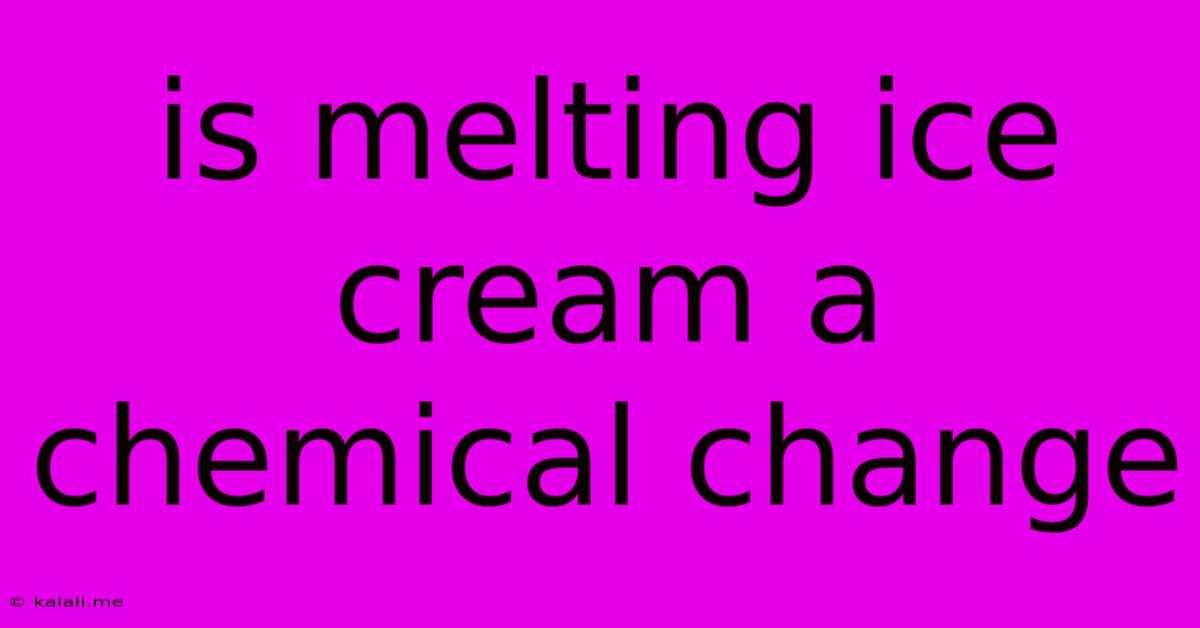Is Melting Ice Cream A Chemical Change
Kalali
May 09, 2025 · 3 min read

Table of Contents
Is Melting Ice Cream a Chemical Change? A Delicious Dive into Chemistry
Is melting ice cream a chemical change or a physical change? This seemingly simple question opens the door to a fascinating exploration of states of matter and the nature of chemical reactions. The short answer? Melting ice cream is a physical change. But let's delve deeper into why.
This article will explore the difference between physical and chemical changes, examining the process of ice cream melting and explaining why it falls under the category of a physical change, not a chemical one. We'll also look at some common misconceptions and address related questions.
Understanding Physical and Chemical Changes
Before we tackle the ice cream conundrum, let's clarify the fundamental difference between physical and chemical changes.
-
Physical Change: A physical change alters the form or appearance of a substance but doesn't change its chemical composition. Think about cutting paper, melting a chocolate bar, or dissolving sugar in water. The substance is still fundamentally the same; only its physical state or form has changed.
-
Chemical Change: A chemical change, also known as a chemical reaction, involves a transformation in the chemical composition of a substance. New substances with different properties are formed. Examples include burning wood, rusting iron, or baking a cake. The original substances are fundamentally altered.
Why Melting Ice Cream is a Physical Change
When ice cream melts, it transitions from a solid state to a liquid state. This change is solely about the arrangement of molecules within the ice cream. The water molecules in the ice cream, along with the fats and sugars, are simply moving more freely. No new substances are created during the melting process. The chemical composition of the ice cream remains the same—it's still water, fat, sugar, and other ingredients, just in a different physical state.
You can even reverse the process (at least partially) by refreezing the melted ice cream. This reversibility further confirms that only a physical change has occurred. While the texture and taste might be slightly different after refreezing, the underlying chemical makeup remains unchanged.
Addressing Common Misconceptions
Some people might argue that the change in texture and taste upon melting indicates a chemical change. However, these alterations are due to the physical rearrangement of the components, not the formation of new substances. The change in flavor is a result of the redistribution of components within the mixture. The change in texture is due to the change in state from solid to liquid.
Related Questions: What About Spoiled Ice Cream?
Spoiling ice cream is a chemical change. This is caused by bacterial growth and enzymatic reactions that alter the chemical composition of the ice cream, resulting in off-flavors and odors. This is a different process entirely from simple melting.
Conclusion: It's All About the Molecules
In summary, melting ice cream is a physical change. The change in state from solid to liquid is driven by the increased kinetic energy of the molecules, altering only their arrangement and not their fundamental chemical composition. Understanding this difference highlights the importance of differentiating between physical and chemical processes in observing everyday phenomena. So, next time you enjoy a melting scoop of ice cream, remember the fascinating chemistry happening right before your eyes!
Latest Posts
Latest Posts
-
Jaguar Adaptations In The Tropical Rainforest
May 10, 2025
-
How To Find Average Velocity From Velocity Time Graph
May 10, 2025
-
What Is Non Living Things In The Ecosystem
May 10, 2025
-
How Many Fl Oz In 6 Cups
May 10, 2025
-
What Is 1 Percent Of 5000
May 10, 2025
Related Post
Thank you for visiting our website which covers about Is Melting Ice Cream A Chemical Change . We hope the information provided has been useful to you. Feel free to contact us if you have any questions or need further assistance. See you next time and don't miss to bookmark.